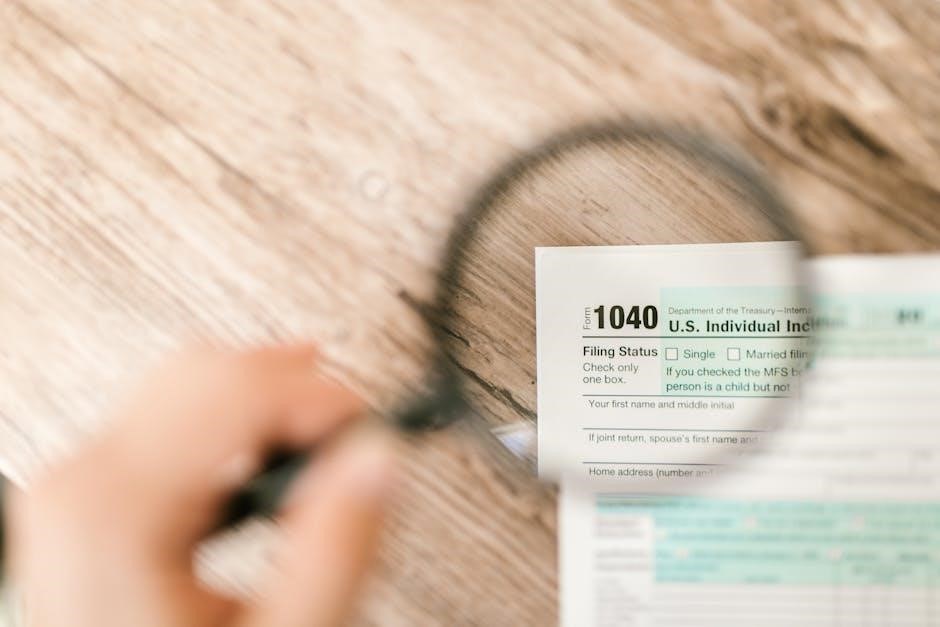
montana form 2 instructions
Montana Form 2 is the primary form for filing individual income tax returns in Montana. It is used to report taxable income, calculate tax liability, and claim credits.
Overview of Montana Form 2
Montana Form 2 is the official form used by residents to file their individual income tax returns. It is a two-page document designed to report taxable income, calculate tax liability, and claim eligible credits. Page 1 focuses on taxable income, credits, and payments, while Page 2 is dedicated to calculating Montana resident income tax liability. The form requires reporting federal adjusted gross income, deductions, and adjustments to determine state taxable income. It also provides opportunities to claim credits such as the Earned Income Tax Credit and the Elderly Homeowner/Renter Credit. Understanding Form 2 is essential for accurate tax filing in Montana.
Purpose of the Form
The purpose of Montana Form 2 is to allow residents to accurately report their taxable income, calculate their state tax liability, and claim any eligible tax credits. It serves as the primary document for filing individual income taxes in Montana, ensuring compliance with state tax laws. The form is structured to guide taxpayers through income reporting, deductions, and credits, ultimately determining the amount owed or refunded. Its clear format helps streamline the filing process, making it easier for residents to meet their tax obligations efficiently.

Eligibility Criteria for Filing Montana Form 2
Montana Form 2 is for state residents and part-time residents with Montana income. It is required for individuals to report their income and calculate tax liability.
Who Needs to File Form 2?
Montana residents, part-time residents, and individuals with income sourced from Montana must file Form 2. This includes those earning income within the state, regardless of residency status. Non-residents with Montana income also need to file. The form is required for reporting income, calculating tax liability, and claiming eligible credits. Even individuals with no Montana filing requirement but eligible for specific credits may need to submit Form 2. Filing status and residency requirements further determine who must complete and submit the form.
Filing Status and Residency Requirements
Filing status options include single, married filing jointly, married filing separately, head of household, or qualifying widow(er). Montana residency is determined by domicile, where you maintain a permanent home and intend to return. Full-year residents report all income, while part-year residents report only Montana-sourced income; Non-residents with Montana income must file if their income exceeds state thresholds. Residency status affects taxable income calculation and eligibility for certain credits. Proper classification ensures accurate tax liability and compliance with state regulations. Understanding residency rules is crucial for correct Form 2 submission.

Understanding the Structure of Montana Form 2
Montana Form 2 is divided into two pages. Page 1 covers taxable income, credits, and payments, while Page 2 calculates Montana resident income tax liability.
Page 1: Taxable Income, Credits, and Payments
Page 1 of Montana Form 2 focuses on reporting taxable income, claiming credits, and detailing payments. It begins with federal adjusted gross income from Form 1040, line 11, and adjusts for Montana-specific deductions. Taxpayers list their Montana taxable income, subtract applicable credits, and calculate total tax liability. This page also includes sections for tax credits, such as the Earned Income Tax Credit, and payments made through withholding or estimated taxes. It serves as the foundation for determining the taxpayer’s overall financial obligations to the state of Montana.
Page 2: Calculating Montana Resident Income Tax Liability
Page 2 of Montana Form 2 is dedicated to calculating the taxpayer’s Montana resident income tax liability. It begins with the federal adjusted gross income reported on Page 1 and applies Montana-specific deductions and adjustments. The form then guides taxpayers through the application of Montana income tax rates to determine the taxable income. Credits and payments from Page 1 are subtracted to arrive at the final tax liability. This page ensures that residents accurately compute their state tax obligations, adhering to Montana’s tax brackets and regulations.

Calculating Montana Taxable Income
Montana taxable income is determined by reporting federal adjusted gross income and applying state-specific deductions and adjustments, ensuring accurate calculation for state tax purposes.
Reporting Federal Adjusted Gross Income
Federal adjusted gross income (AGI) from Form 1040, line 11, is the starting point for calculating Montana taxable income. Taxpayers must accurately report this amount on Montana Form 2, ensuring all federal adjustments are included. This step is crucial as it directly impacts the state tax calculation. Proper reporting ensures compliance with Montana tax laws and accurate assessment of tax liability. Any errors in this step could lead to mismatches with federal filings and potential audits.
Deductions and Adjustments
Deductions and adjustments are subtracted from federal adjusted gross income to determine Montana taxable income. Common deductions include the federal standard deduction or itemized deductions, as reported on Form 1040. Adjustments may include specific state allowances or modifications, such as educator expenses or retirement income exclusions. Taxpayers must carefully review Montana-specific rules to ensure all eligible deductions and adjustments are claimed. Proper documentation, such as receipts or supporting forms, may be required to validate these claims during audits or reviews.

Credits and Payments
Montana Form 2 allows taxpayers to claim various credits, such as the Earned Income Tax Credit and Elderly Homeowner/Renter Credit. Payments can be made via e-file or mail.
Available Tax Credits
Montana offers several tax credits to reduce taxable income. The Earned Income Tax Credit (EITC) is available to low-to-moderate-income workers. The Elderly Homeowner/Renter Credit provides relief for qualifying seniors, even if they don’t meet the state’s filing requirements. Other credits include those for education expenses, child care, and renewable energy investments. Taxpayers must complete specific sections of Form 2 to claim these credits, ensuring they meet eligibility criteria and submit required documentation. Properly claiming these credits can significantly lower tax liability.
Submission and Payment Methods
Montana Form 2 can be submitted electronically or by mail. E-filing is recommended for faster processing and refunds. Payments can be made online via the Montana Department of Revenue’s website or by check. When filing by paper, include only the first two pages of Form 2 and any relevant schedules with values. Do not submit blank schedules. Payments must accompany the return if taxes are owed. For electronic filers, direct deposit is available for refunds. Always verify submission deadlines and payment options on the Montana Department of Revenue’s official website.

Tax Liability and Calculation
Montana Form 2 calculates tax liability by applying state tax rates to taxable income, considering federal adjusted gross income and applicable deductions, credits, and payments;
Montana Income Tax Rates and Brackets
Montana’s income tax system uses a progressive structure with multiple brackets; The rates range from 1% to 6.9%, depending on taxable income. Single filers pay 1% on the first $3,100, 2% on income up to $5,400, and higher rates for larger amounts. Joint filers have slightly higher thresholds. The highest rate of 6.9% applies to income exceeding $18,400 for single filers and $36,800 for joint filers. These rates are applied to Montana taxable income after deductions and exemptions, ensuring a fair tax calculation based on income level.

Reporting Requirements and Additional Information
Montana Form 2 requires accurate reporting of income, deductions, and credits. Ensure all necessary schedules and supporting documents are included to avoid delays in processing your return.
Necessary Documentation and Schedules
When filing Montana Form 2, ensure you include all required documentation and schedules. Attach Schedule A for itemized deductions and Schedule D for capital gains. Submit W-2s, 1099s, and other income statements. Include federal Form 1040 and any applicable schedules. If claiming credits, attach supporting forms, such as those for the Earned Income Tax Credit or the Elderly Homeowner/Renter Credit. Only include schedules with reported values; blank schedules should not be submitted. Accurate documentation ensures timely processing of your return.
Where to File and Deadlines
To file Montana Form 2, submit it electronically through the Montana Department of Revenue’s e-file system or mail it to the address listed on the form. The standard deadline for filing is April 15th. If you need an extension, you can file by October 15th. Ensure your return is postmarked by the deadline to avoid penalties. Visit the Montana Department of Revenue website for the most accurate filing information and resources to assist with your submission.
For more information, visit the Montana Department of Revenue’s website. Resources include updated forms, instructions, and e-filing options for a faster refund process.
Final Steps and Submission Tips
After completing Montana Form 2, review all entries for accuracy. Ensure all required schedules and documentation are included. Submitting electronically is recommended for faster processing and refunds. If filing by mail, use the address provided in the instructions. Double-check your calculations and verify your eligibility for credits. Keep a copy of your return for your records. For assistance, visit the Montana Department of Revenue’s website or consult a tax professional. Ensure timely submission to avoid late filing penalties.
Additional Resources for Assistance
The Montana Department of Revenue’s website offers comprehensive resources for Form 2, including downloadable forms, detailed instructions, and FAQs. The official 2023 Montana Form 2 instructions provide guidance on filing requirements, income reporting, and available credits. Taxpayer assistance hotlines are available for personalized support. Additionally, local tax professionals and organizations like the AARP offer free or low-cost help, especially for seniors and low-income filers. For further clarity, consult the booklet or contact the Department directly. Keep a copy of your completed return and all supporting documents for your records.

